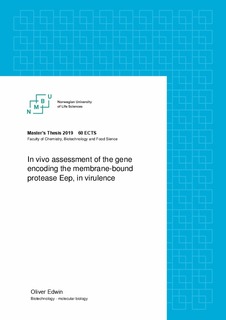| dc.contributor.advisor | Diep, Dzung Bao | |
| dc.contributor.author | Edwin, Oliver | |
| dc.date.accessioned | 2019-12-18T10:40:23Z | |
| dc.date.available | 2019-12-18T10:40:23Z | |
| dc.date.issued | 2019 | |
| dc.identifier.uri | http://hdl.handle.net/11250/2633880 | |
| dc.description.abstract | The increasing prevalence of antimicrobial resistance and the lack of innovation in developing new antibiotics has only emphasised the need to develop new antimicrobials. Therefore, research has focused on antimicrobials that target mechanisms other than those targeted by traditional antibiotics. A potential virulence enhancing extra cytoplasmicfunction (ECF) in Enterococcus faecalis was found to be targetable by bacteriocin EJ97, a promising antimicrobial candidate. In this study, we use the bacteriocin EJ97 to target the Eep, a membrane-bound proteinase. Using EJ97 as a selective agent on sensitive E. faecalis strains, we isolated thirty-six mutants resistant to the bacteriocin. The eep gene in the resistant mutants was DNA-sequenced, and nine of the thirty-six isolates were found to contain a severe frame shift mutation early in the gene, resulting in a stop codon, effectively truncating Eep. To investigate whether the eep gene was relevant in the virulence of E. faecalis, these mutants were included in a murine skin-wound model testing for E. faecalis virulence. After three days in the murine skin-wound model, the difference in colony-forming units between the mutants and the wildtype was investigated. No significant differences between the mutants and wildtype were found. | nb_NO |
| dc.description.abstract | Utbredelsen av antimikrobiell resistens blant mikroorganismer sammenfattet med mangelen på innovasjon og utvikling av nye antibiotika har formet et kraftig behov for utvikling av nye alternative antimikrobielle midler. Dette har ansporet forskningen til å fokusere på antimikrobielle midler rettet mot andre mekanismer enn de tradisjonelle antibiotika rettes mot. I Enterococcus faecalis, ble en potensiell virulensfaktor Eep, en del av bakteriens «ekstra cytoplasmiske funksjon (ECF)» funnet å være reseptor for bakteriocinet EJ97, noe som gjør den til en lovende antimikrobiell kandidat i kampen mot multiresistente bakterier. I denne studien bruker vi bakteriocinet EJ97 som et selektivt agens på sensitive stammer av Enterococcus faecalis for å isolere trettiseks mutanter resistente mot bakteriocinet. Genet eep ble DNA-sekvensert i de resistente mutantene, og bekreftet at ni av de trettiseks isolatene inneholdt en alvorlig «frame-shift» mutasjon plassert tidlig i genet. Denne «frame-shift» mutasjonen resulterte i et stop-kodon, som medfører en avkortning av Eep. For å undersøke på hvordan måte og i hvilken grad eep er relevant som virulensfaktor i Enterococcus faecalis, ble mutantene inkludert i en hud-sårmodell i mus, som testet for deres virulens. Etter tre dager i hud-sår modellen i mus, ble forskjellen i «colony-forming units» mellom mutantene og villtypen undersøkt. Ingen signifikante forskjeller mellom mutanten eller villtypen ble funnet. | nb_NO |
| dc.language.iso | eng | nb_NO |
| dc.publisher | Norwegian University of Life Sciences, Ås | nb_NO |
| dc.rights | Attribution-NonCommercial-NoDerivatives 4.0 Internasjonal | * |
| dc.rights.uri | http://creativecommons.org/licenses/by-nc-nd/4.0/deed.no | * |
| dc.subject | EJ97 | nb_NO |
| dc.subject | Bacteriocin | nb_NO |
| dc.subject | Mice | nb_NO |
| dc.title | In vivo assessment of the gene encoding the membrane bound protease Eep, in virulence | nb_NO |
| dc.type | Master thesis | nb_NO |
| dc.description.localcode | M-BIOTEK | nb_NO |

